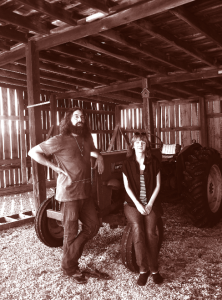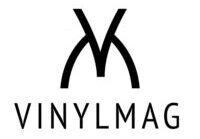
One of these days, the owners of Max and Farm 255 will meet for drinks and hash out a truce to end the noise war that plays out every Friday and Saturday night in downtown Athens. As of Fri., Oct. 26, that day had still not yet come. Nevertheless, psychedelic ambassadors MV & EE battled the wall of dance music from Max next door and delivered a particularly intense set of far out folk, at one point going so far as to cease fighting and actually capitalize upon the sonic interference from next door.
Despite the looping caterwaul the band had created on stage, there came a moment midway through the set when a strong dose of four-on-the-floor bass drifted over from the Max patio and settled over Farm’s own outdoor area, easily equaling in volume, if not quite drowning, MV & EE’s wailing improvisation. But instead of halting the show or even shooting their neighbors a dirty look, the duo simply locked into the newly introduced tempo and continued to jam, deftly reorienting the song to accommodate the ineluctable. Looks of confusion gave way to a ripple of knowing smiles as, one by one, the crowd caught on to the musical hipshot it had just witnessed.
The openness of MV & EE’s performance style makes this kind of spontaneity an ever-present possibility. All night, clean, fingerpicked guitars and hushed vocal harmonies established breathing room, humming along gently before crashes of distorted chords and screaming lap steel tore jagged holes in the meticulously woven fabric. While Matt Valentine jerked his instruments all over the place, physically wringing every last overtone from his slew of guitars and banjos, Erika Elder remained almost eerily stoic. Both performers exhibited great degrees of control, handling the musical violence like vengeful, feedback-hungry deities stomping out the cities named in their respective honors. Yet the term “indulgence” was absent from the post-show discussion; instead, the abrupt turns and extended crescendos scanned as pure, veneer-stripped exploration. Valentine often spent long periods crouched in front of his amp, head bent to receive his own punishment in the pursuit of perfect screaming sustain or the right brand of squall from his juiced-up, phaser drenched machines. Meanwhile, Elder lent voice to the madness, squeezing tender melodies out of her armory of lap steels and various oddities, the highlight of which had to be the “Mandobird,” a miniature Gibson Thunderbird strung like a mandolin.
It was an appropriately radical device for a radical night. Between the late start time, the two-party decibel pissing contest and sudden cold snap outside, nothing went exactly as expected – all of which only gave a couple of seasoned performers an excuse to jettison expectation altogether.
____________
Below, check out VINYL’s exclusive interview with Valentine:
Vinyl Mag: You guys have a reputation for being especially prolific, coming out with new records several times a year and touring hard behind them. How does recording compare to playing live?
Matt Valentine: They’re all the same in theory, but the records take, in some cases, a really long time to make, whereas the live experience is so nice because it’s immediate and, as you play, you’re reacting to so many things in the environment, things that aren’t necessarily great for a record, but are very appropriate for that moment in time. Sometimes things that sound really cool live have a space, but they don’t necessarily need to find their way onto something that is going to be a little more of an expensive release for someone to buy and listen to.
That’s where we came up with Heroine Celestial Agriculture, which is a subsidiary of our long-running cottage label called Child of Microtones. We’ve been doing that since 1999. For the Heroine thing, we basically harvest these live shows – they’re unadulterated but nicely cleaned up – I comb over them with mastering, and we spend a lot of love making sure they sound good and have a nice vibe to them. They’re basically like the lowest forms of art [laughs], and the LPs are like the highest form of art. And knowing that we have something going with that, as well as having these great labels that want to do albums that we’re interested in, the lines aren’t as blurred as they could be, but the ultimate thing is just trying to get cool-sounding stuff down and out to other people to hear.
VM: Does most of that creativity spring from working things out on tour, or exploring more plentiful and expansive options in a studio environment?
MV: It mainly stems from having a good work ethic. We’re into playing music as much as possible and dig being around music and creative people as much as possible. That inspires us. The studio environs are cool for a different kind of color; it’s expansive but not as ephemeral, and that aspect of it is terrifying. We try to find a balance. I get into this thing called “spectrasound” which has the sound dancing all around the stereo field- the aim is that people should want to keep coming back to take a spin.
VM: Your sound has changed fairly significantly over the years, encompassing everything from classic folk arrangements to some pretty spaced-out adventures in improvisation. Is there a conscious arc to your development, or does each batch of songs reflect the specific things going on in your lives at the time?
MV: I think the “space” and the jams were always in there, as were the songs/compositions. We’ve also always mixed amplification with the folk forms. I reckon the conscious arc is, “Don’t look back, set the controls to future wave.” Sure, the songs are snapshots of the sounds of the environment…it all gets in there. I dig topical songs, but I don’t think we’d ever get a six-figure deal on topic.
VM: A lot of notable songwriters — especially those incorporating roots elements into their music — seem like they’re pushing toward their own perfect vision of the cleanly composed, A-B-A-B ideal. You guys frequently seem more focused on faithful, moment-by-moment transmissions of vivid impressions, pulling the listener onto the banks of a river or into the passenger seat on a long drive. Can you talk a little bit about your approach to capturing experience in your chosen medium?
MV: Yeah, A-B-A-B can be a drag; we try to bring some chaos theory and extended love-ins into that form. It’s a groovy formula, but we love to break traditions.
VM: Did you engineer Space Homestead yourself, or were you working with a producer?
MV: I guess I was the chief engineer, but there are other engineers on it. We worked with Jarvis Taveniere, who’s got the Rearhouse studio, the original Woods studio. We also worked a little bit at Buttermilk Falls, which is Jeremy Earl’s home studio, and I engineered sessions with that, but he helped me, since were just doing the D.I.Y. thing in his studio. Erika and I engineered some stuff at our house, and Justin Pizzoferrato engineered some of the cuts at his studio in Greenfield, Mass.
It helps to have someone else twiddling the knobs, so you can just use one side of your brain [laughs], not burning synapses worrying about levels so much as playing notes. But usually we like to do them ourselves. Woodsist pressed the album on their label and did the distribution.
VM: What did each participant bring to the sound of the album?
MV: We definitely get along with everyone who plays on the records on more than just a musical level. Otherwise, I don’t think we could work with them. They’re like extended family, and we have a kind of deep bond where sometimes you don’t need to speak much or even really give much direction. They’re people who are just really groovy players, so they bring a spirited and inspired vibe when they play. I think that’s most important.
VM: What do you think you’d be doing if you weren’t going at it full-time with the band?
MV: Oh, man. At this point, I don’t think I know anything else [laughs]. I think I’m kind of grandfather claused in and out…stuck. We used to sell records – we worked in record stores together for a long time, probably a good 15 years. I started working in record stores as a teenager. Record stores still exist, but on a different level than when I cut my teeth in them.
I do a lot of mastering for bands. I do our own label. Erika does a lot of graphic art. She does pretty much all the layout for all the records. She works for a few pretty wild organizations freelancing up in Vermont. There’s this thing called Strolling of the Heifers, which is a big annual parade for farmers and local businesses.
You know, I’d probably be doing something in agriculture. It’s like I’m already doing sonic agriculture; I’d probably dig my hands a little deeper into the dirt, grow some vinyl on vines [laughs].

